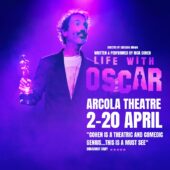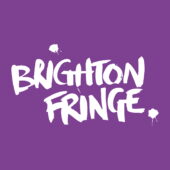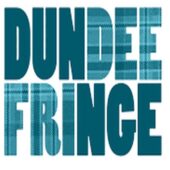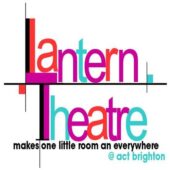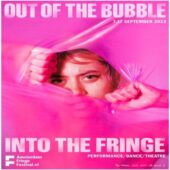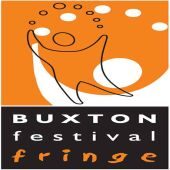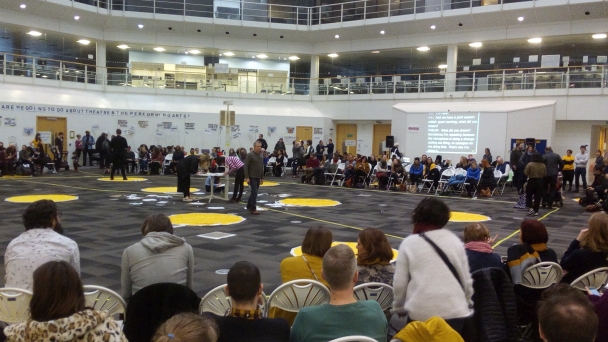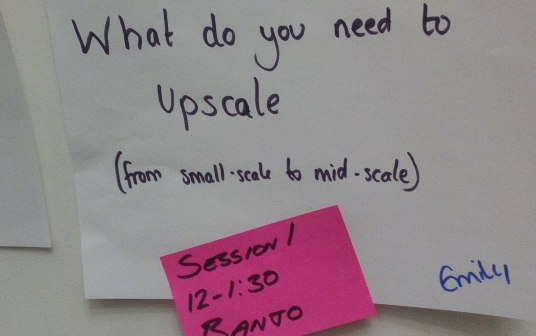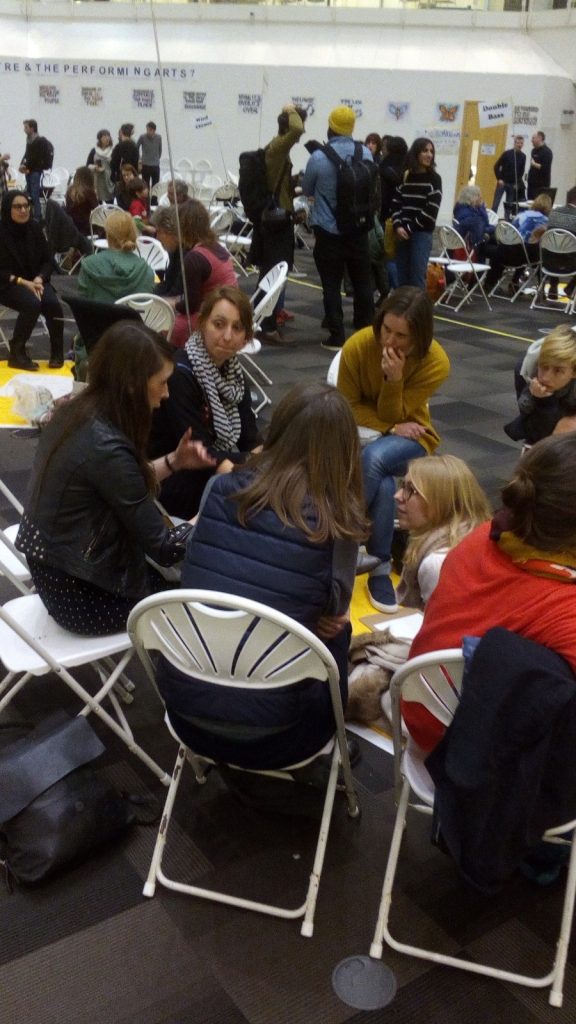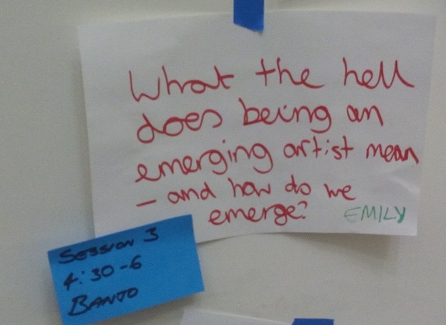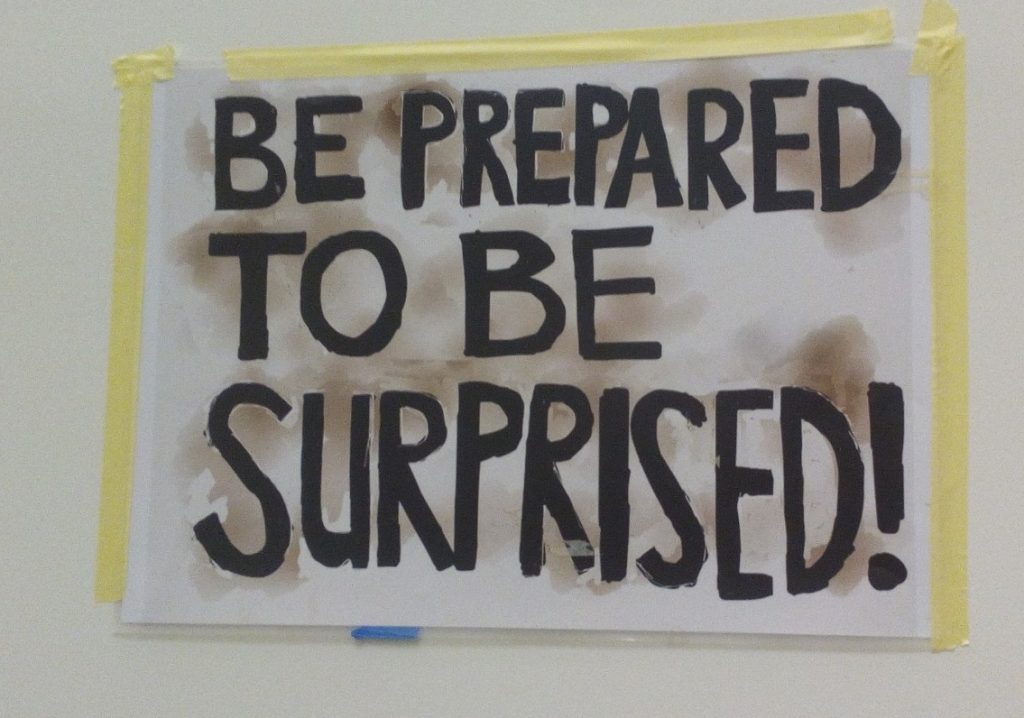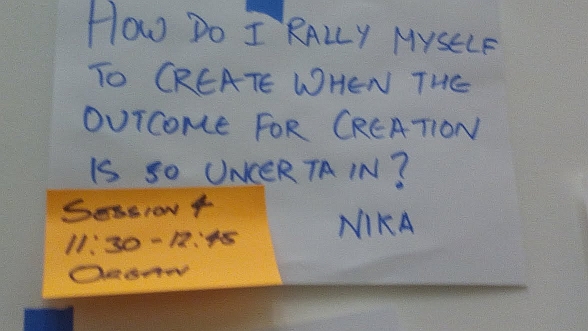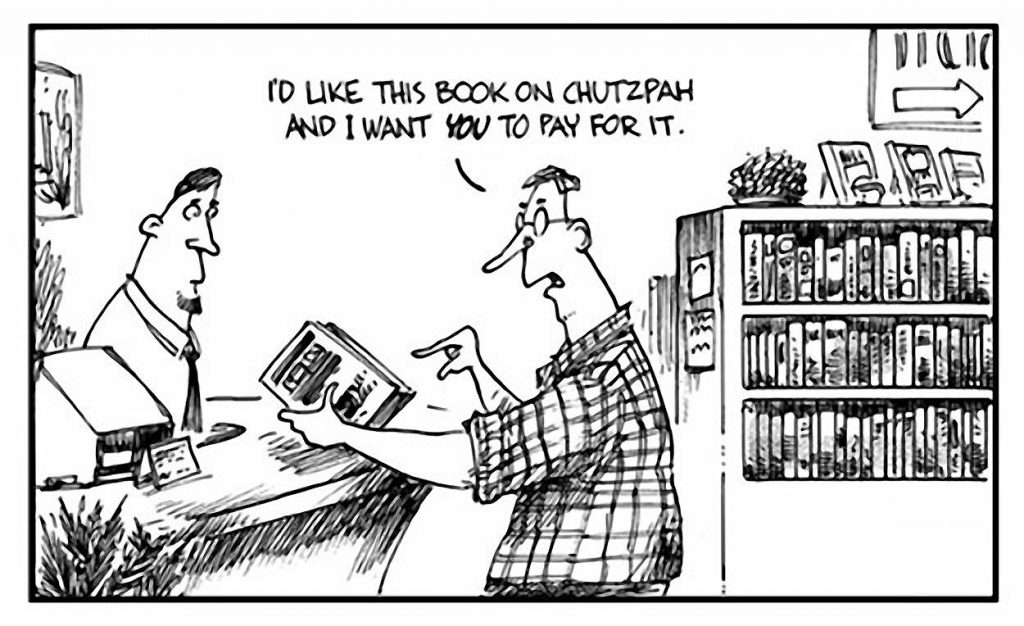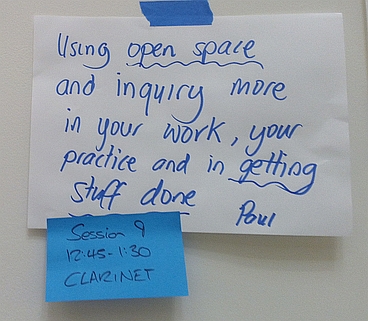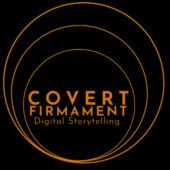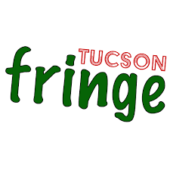Here FringeReview’s editor Paul Levy posts his reflections and reports from Devoted and Disgruntled, 2013 20-22nd January 2018, at the New Diorama Theatre. Paul is a writer, theatre maker at Rational Madness, and conversation enabler.
“D&D is an opportunity for arts people at every point in their careers, from audiences to artists, CEOs to FOH staff, grassroots groups to seasoned professionals, to come together and focus on the question WHAT ARE WE GOING TO DO ABOUT THEATRE AND THE PERFORMING ARTS?”
The meeting uses Open Space Technology. (Also visit my own Open Space writings here).
My invitation going into Devoted and Disgruntled 13
“The rise of millennials (and there is even talk of Generation A, just over the horizon!), have we lost trust in traditional hierarchical forms of organisation, those “vertical structures”? – the ladders of status and control….?
Many people no longer trust banks, politicians, their bosses and even their theatre producers and directors. At the many Fringe festivals I attend (and have created theatre for), and also review for as editor of FringeReview, I see more and more theatre work not even attempting to “go upwards” to apply formally for funding from increasingly cash-strapped and/or selective and elitist funding organisations, and, instead, heading out more horizontally to crowd-fund, to invite those “on our level” to value art with real steps of support. The strings attached when we entreat our peers and communities to fund us come from we, the art makers. Is that a good thing?
There was over 5 billion pounds lent last year in the UK between friends and family and the rise of alternative currencies such as Bitcoin avoid banks altogether. In the absence of flow in the more traditional vertically designed organisation we are opting for easier routes. But are we also feasting on each others’ flesh?
Is horizontal trust the main future for theatre makers? Does it let off the traditional funders too lightly? What are the downsides and upsides of horizontal trust? When we devise work, is the traditional role of the director sometimes lost? What is lost and what is gained?
Devoted and Disgruntled is the most important and even vital conversation space for such questions and I invite you to bring your restlessness to a horizontally trusting community. There are no bosses, no directors and over-stuffy facilitators. Space opens and then the thoughts and impulses take flight, way beyond the event in itself.
My steps lead me towards London… I hope to meet you.”
__________________________________
Day 1 – Saturday
The Space opened quickly. What does that mean? Our host, Phelim McDermott described the process and invited people to offer sessions that were posted to the timetable and, within half an hour, the programme was full of sessions offered in an event curated by the participants themselves.
I chose three sessions.
The first explored the challenges of upscaling theatre work from small to medium (hosted so well by Emily). Can all small scale work be up-scaled? Many in the conversation gave examples of work that needs only a few tweaks to be ready for larger venues. Venues need to be prepared to put faith in companies and take the necessary risks – they can be too risk averse. There may well be support from venues to help promising work upscale.
You may not want to upscale, from an artistic point of view, but there are economic opportunities in terms of making your work more financially sustainable. But the ambition to upscale has to be full-hearted and authentic.
Upscaling, at least temporarily or as a pilot project can be easier during Fringe festivals – especially regional ones where venues can be more generous with their space and keen to attract new work from outside their region, especially if those smaller scale productions come with reviews – they do need to have provenance.
The second session I attended was all about the costs of Edinburgh, specifically, the Edinburgh Fringe (hosted with passion and oomph by Claire). There was a a debate about how the Fringe (and the wider city, for example, landlords and venues) can be persuaded too act on rising costs, even outrageous costs, that mean the open access nature of the fringe is sorely undermined by the haves and have nots, and the Darwin-fest the Fringe has become.
Suggestions included holding a D and D regional open space on the issue in the heart of the Fringe. There has been a D & D in Edinburgh before and Phelim later suggested there was some historical wisdom on the ground to be tapped into here. I imagine it isn’t ready to hold an open space in such diary-busy chaos.
Research needs to be done to survey what current and past participants think of costs, and objective data about rents, venue deals etc my expose the horrendous nature of costing and even possible exploitation. Do we need a union? Do we need a strike? Will the fringe and major venues wake up to a campaign or protest?
This was a vibrant and passionate discussion that was supportive of attempts to get objective data out into the public domain about how unfair the fringe can be and how costs are rising year on year forcing arts makers to lose lots of money.
Yet do we all have to play the game? Can resident artists in Edinburgh continue to offer cheaper accommodation to fellow artists? Can and should the Fringe Society and Festivals Edinburgh do more? Do we need an app like Glassfloor that rates and outs bad behaving venues?
Key issues identified were the soaring cost of rented accommodation and the high guarantees performers have to pay venues. Do venue financial models need to be more transparent ? Would venues change if there was a recognised and respected rating – an independent stamp of quality across the whole fringe?
Finally, on day 1, I went to a session about what being an emerging artist really means and how does an artist actually emerge? (hosted by Emily)
Is it about how we present ourselves via social media and our web sites? Is it about how we see ourselves? Do we need to use the term “emerging” at all? Certainly we can be helped to emerge through mentoring, through targeted funding for promising work and also when we showcase our work i ways that show how exciting and unique, ground-breaking our work is. There is a danger we can peak too early, become complacent, or end up lost in a PR game. In the end, our self-view is important, remaining true too ourselves without become to self-obsessed. Ultimately our own emergence will be unpredictable and potentially surprising.
“Emerging” is both self-defined and also revealed to us though the response of our trusted peers, critics and our audiences. Emerging can be exciting for us, but also can become a kind of fake PR-term. It was good to share experiences and stories during this session.
In my own work in philosophy, emergence is often defined when new properties of a developing system arise which cannot be explained in terms of the original properties of that system. When we “emerge” as artists, people who know us tell us we have changed (for better or worse!), our development can make us unrecognisable to people who knew us a long time ago and then meet us again later in life. Emergence is developmental, evolutionary and, when we seem very transformed, it can be called revolutionary. We can also emerge in terms of our traits, our skills and attitudes as a performer (becoming known for our uniqueness, our controversy, our impact in our field as a personality) and/or we can emerge in terms of our work. It can be hard to distinguish between these two, but some people find it important to do so: “My work may have changed, my approach as an artist may have changed, but I am still the same person as I was ten years ago!” Emergence can make us uncomfortable because we can lose recognition of aspects of ourselves, or our emergent qualities can be labelled by others in ways which challenge us, make us uncomfortable or which we don’t agree with. The description of an emerging artist by others can confirm our development or contradict or view of it.
Emergence can also label us. What happens once we’ve emerged. Does emergence ever stop as process, asked one member of the group discussion. Once we have emerged do we then become stagnant> Do we converge as a new show becomes a fixed, repeating tour? Not everyone in the group found the idea of emerging helpful or wanted. For others, it is an anchor point in personal change and career development.
There was a lot of empathy in the conversation and I think some almost instant fledgling friendships were formed.
I’m looking forward to Day 2.
Day 2 – Sunday
Today I chose 4 sessions.
First off I went to a session on “How do I rally myself to create when the outcome for creation is uncertain?” This was combined with another session about fear. There were several dancers in the group and one story was shared where the dancer had started a project confidently with good intentions but had experienced performers being unreliable and ending up in a situation of compromise with a project that wasn’t able to be realised.
The person had lost their confidence over time as this happened. As a dancer, she had gone back into the rehearsal room to remind herself that she could dance and that it wasn’t her skills at issue here but the unreliable and uncertain word of making performance. There was a lot of fellow feeling in the group for this situation.
In times of little funding, and in a commitment-phobic world, projects can easily fall when there are no clearly enforceable contracts of attitudes of firm commitment right through a development process. We can easily lose our mojo!
Fear can come from our upbringing and our temperament. It can be helped by professional support and also the support of our peers, but we can carry fear with us a long time. Festivals such as Edinburgh Fringe and also very commercial venues can be harsh places that add to our sense of uncertainty and fear.
Fear itself may aid the creative process and is actually close often to excitement. Physical excitement and fear are primeval things and they can actually be beneficial but the fear in our heads – our constant worry and the stories of being let down that we collect in our lives can make us cautious and risk averse.
This conversation opened up a lot of questions and I felt humbled by the honesty of clearly talented and passionate theatre and performance makers in the group. I’m not sure how much was resolved in the conversation.
Sometimes we may have to get out of the groups we are currently in and seek new pastures, especially if the arts communities we are in aren’t very committed, are complacent or when we are just in a place of repetition.
It was suggested that some arts communities in other parts of the world, where communities live and work together may be places we should consider exploring, as well as cooperatives and collaborative projects where several companies share resources. This sometimes happens at big festivals where we are stronger together than competing with each other.
Ultimately sharing can be a powerful thing, but we are also unique and fear and uncertainty, and how to resolve it, will be different for each of us.
The second session was really hands-on and was about performing theatre in non-traditional venues, and asked if they should always be made to site-specific? The group answer was no. The example offered was a tour of a version – a new translation – of the 1001 Nights – a storytelling show but also one about being someone from an Arabic background living in the UK. Venues included a foootball club, a charity shop and a library!
Should we adapt our work to the performance space? Should we leave it as it is? Or should we make it completely site-specific?
One view was that small, creative tweaks could help. For example, in a library, the performer could acknowledge the space by taking a book down from a library shelf. In the charity shop, he might browse a bit on entry and pick up an evocative object before starting. In all cases, the audience (an audience more used to traditional theatres), there could be creative ways to acknowledge the space but it should never be a gimmick – there should always be known creative intention behind it.
This was a show that had played to decent reviews in a lecture room at Summerhall at the Edinburgh Fringe 2016 and the response had been that the lecture room worked as an intimate space, “like being in the company of a friend”. One idea was to further experiment with the show in a non-traditional setting, and the performer suggested doing it at home to an invited audience.
This was a very inspiring conversation about the positive reasons but also artistic challenges of taking theatre work to non-theatre spaces. There’s a danger if we become victims of the space, and an opportunity if we find and make use of that space’s virtues authentically. Less is often more. Keep the choices, gentle, often a minimalist intervention can have the greater impact.
On Day 2 in the afternoon I hosted a session called “How to succeed at Fringe Festivals on your own terms. “. After reflecting on day 1, I changed the original title which was “The Filthy Guide to the Edinburgh Fringe” to this one because it seemed to reflect better my invitation to a fresher conversation about having an authentic Fringe experience as a theatre maker that wasn’t just about “playing the game” and becoming a winner.
Some members of the group talked of having lost a lot of money at past Fringes in Edinburgh and others about finding the whole experience paradoxically exciting but also stressful.
The Fringe is a game, with rules for success, but, over the years, I have met theatre makers who have decided their Fringe on their own terms, buy making their own game, but questioning the fixed way of things and doing things their own way. here are a few examples that came up during the discussion:
– not playing the whole month
– playing just a few days
– bringing new, work in progress to the Free Fringe or even finding a non-Fringe venue and simply being a successful part of the month (without losing thousands and still finding audience
– not flyering, paying others to flyer and focusing totally on the work
– deciding which, if any reviewers come
-not reading reviews during the fringe, just focusing on the work and the joy of creation and realisation
– not going at all!
– only going if there is funding in place (we had examples of applying to Northern Stage and going with a stable of shows with PR and other support in place or with HOUSE
– connecting with others in advance to reduce costs (for example where six solo performers live in a house together, reducing overall rent and also not living alone!)
It is we who define what success means and it is dangerous to surrender to the narrow measures of money and audience usually touted by venues and PR people. Never lose your rootedness in creation of your work!
The Fringe has become very gamified but you don’t have to be a surrendered victim of that game. You can make your own rules and even create your own venue. One example was a hot desk meeting space which a performer turned into a venue at short notice with the help of the venue itself. (It was called The Melting Pot).
This was a very “real” discussion about holding your own as an artist in a trade fair fringe. It requires self-belief, peer group support and faith in your work.
The last session I went to comprised three very creative and warm people (and we were later joined by a fourth person). |t was supposed to be a session about stepping away from expectation and “wanting” things, but the host hadn’t turned up! So a different session emerged, exploring “chutzpah”. A fledgling “chutzpah club” was also formed. Chutzpah is a Yiddish word that means going for something that pushes the envelope, being cheekily bold.
The scenario explored was real. A member of the group wanted to set up a one person full time university to develop young, intelligent, conscious and life-ready young people. We explored the recent rise of what used to be prevalent in Victorian times – that of arts patronage, where rich fol would give money to artists to support their work. Boom! Have a million! I like what you do so go and do it! That was our romantic notion and another member of the group, holding an Irish penny that represented a million pounds was pitched to by the would-be university creator who was loaded with chutzpah! She was grilled and questioned but the faux-millionaire gave her the penny/million!
The exercise was really a metaphor for a new kind of arts funding alternative to formal channels such as the Arts Council and even recent more horizontal forms of resourcing such as crowd-funding.
Do we need to just be bold and find the patronage out there? What if we wrote boldly and directly to 100 millionaires with money too offload? No strings attached. Just an unrefusable, clear pitch? A demand even?
Plenty to ponder, frown and smile at here – a session on cushions, yet somehow very upstanding. Watch out for the Chutzpah Club…
Onward to the final day – Day 3 – a day of possible action. So come on all – what ARE we going to do about theatre and the performing arts?
Day 3 – Into Action?!
Phelim re-opened the space on day 3 (though it never really ever closes!). The invitation was to take action and I hosted one session and went to one hosted by Patrick Dixon.
The first session looked at how we can all “drink together at the skills pool”.
Seeing each others’ work, flyering for each other, retweeting generously – yes we all do that. Yet do we still fall into the competitive game? Is there scope for more synery and diving more deeply into each others’ work? Patrick suggested a performance space at the next D and D, and even more connection between performers? We heard stories from some group members about the cabaret scene in London which seems to be more of a mutually supporting community than say, the realm of solo theatre performers.
Patrick made an offer. He has strong connections with the perhaps lesset known yet impressive Steiner Theatre om Park Road London (near Baker Street). He could possibly arrange decent deals for companies wanting to perform there. This was an example of how we can all help each other. The arts is a field, not only a market place!
The second session was about ho w we can use open space more in our work. I led a very rich discussion and examples were shared from one leader about how he uses open space with 200 employees in his organisation. There’s a danger that talk doesn’t have the mandate for action so clear invitations need to be written and shared that are clear in the actual mandate on offer. Phelim’s suggestion of a D and D Satellite Open Space that could actually lead to shared decisions about real funding on the table at the Open Space event itself was echoed in this session where we heard how permission to make decisions could really ignite involvement and commitment.
Open Space need not only be talk. It can be rehearsal, coding a game together, cleaning up our local park as a community. It’s all in the invite and the people who come. We can use open space for anything – and not just in a meeting room, it can happen at home, on our own, and in our local cafe.
The circle closed over the final hour and those new to Open Space celebrated it, there was a lot of genuine surprise t how effective the methos had been over the three days. Proviiding access had really opened the event up to everyone, and there was clearly anticipation, excitement and some trepidation about whether the buzz in the room would translate back into busy schedules after the event had ended.
This D and D has been a bit of a splendid personal exorcism for me and I look forward to the next one and contuing to use Open Space in my own practice. Onwards and upwards, inwards and beyond…
And finally… all parallel lines meet at infinity…
